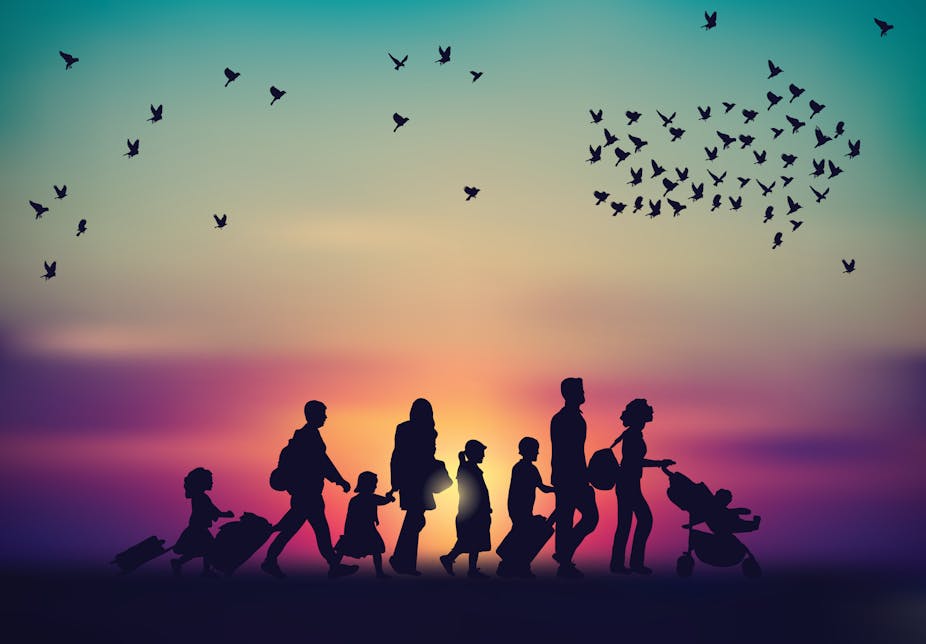The tragic death of four members of a Kurdish-Iranian family attempting to cross the English Channel in late October was a stark reminder of the dangerous lengths people go to try and find safety, particularly in the absence of safe, legal means to seek protection.
No one is born a migrant. Instead, people are constructed as migrants through the ways they are positioned and treated by society. And this uninvited label can have serious effects on how integrated they feel.
In our recent research, we explored the way a migrant identity is assigned to people on the move. Once people are defined as a migrant – by the state, by the media, or by society – it can feel like that label surpasses all other aspects of their identity. They are portrayed as perpetual foreigners, continually marked by their history of moving from one place to another.
We call this process “migrantification”. It’s a phenomenon specific to this moment in the 21st century, which is marked by the hyper-politicisation of population movements across the world’s increasingly militarised borders.
Migrantification brings together the various techniques used to class people into subcategories such as economic migrant, refugee, asylum seeker or illegal migrant. But it also covers the overarching process of making people into migrants in places where the word represents both a formal status in the eyes of the state and a social and political identity.
Read more: Explainer: the difference between asylum seekers, refugees and economic migrants
Made into a migrant
In our interviews and workshops held in London, Birmingham and Nottingham in the UK, and in Pisa and Bologna in Italy in 2017, we asked more than 30 people who had been displaced by conflicts and violence to reflect on how they have been constructed as migrants in their encounters with the state, public institutions, media and other members of society.
Most of the people who we interviewed and became collaborators on the project either were, or had been, in the asylum system. Some had achieved refugee status and some in the UK had taken British citizenship, although this was not the case in Italy. Others had had their asylum claims refused and were living through the painful uncertainty of the appeal process.
We were interested in the moments of recognition when people understood that others viewed them as migrants. In their responses, it became clear that some key terms of immigration control had infiltrated everyday life as new forms of stigma. In particular, the status of asylum seeker was regarded as a highly stigmatised identity. Many of our participants chose not to reveal this status in their day-to-day interactions. One Kurdish man living in Birmingham told us he never mentioned he was an asylum seeker. “If you did, they’d speak to you as a contagious disease.”
Some characterised being a migrant specifically in terms of being subject to state surveillance and control. For example, one man in Pisa traced the moment of being made a migrant to the moment when he was fingerprinted on his arrival in Italy from Burkina Faso without his consent.
We were brought into a military building and after a while they took our fingerprints with a few words. ‘No worry. No worry. Then you’re free.‘ I didn’t know that those fingerprints, taken without any consent, would trap me in Italy for many years to come. Those fingerprints made me a migrant? Maybe. But a migrant without the right to move.
In the UK, some people found being made a migrant meant recognising how easily they were scapegoated by the media. One woman in Birmingham said the constant conversation about immigration by the UK’s main political parties meant that she feels “all the time that I am an immigrant”. She said it felt like politicians were playing a game, speaking about immigration in an effort to increase their performance in the polls.
Read more: Hostile environment: the UK government's draconian immigration policy explained

Double standards
There was also a sense that even for those who showed that they had been a “model immigrant” – by taking British citizenship, or being professionally successful – found they were still categorised as a migrant. This is because being a migrant means never being integrated enough. Our participants were keenly aware of the double standard in expectations to integrate.
As one man living in London, who had got British citizenship, told us he thinks that everybody sees them as a migrant because of their skin and accent.
I’m fed up of people telling me ‘you need to integrate’, so I started to think ‘what do we mean by integration?’ I need to go to the pub to integrate? OK, I accept going with you, but will you come with me on the second day when I asked you to smoke shisha and drink coffee?
It’s this double standard which is at the heart of migrantification: around who has the freedom to move and who does not, who has to risk their life crossing deadly borders and who does not, and ultimately – who is treated with suspicion and who is not.

